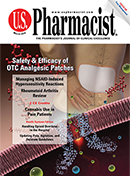US Pharm. 2007;32(3):4.
Without revealing my exact age,
suffice it to say that I am a product of the pre-technical revolution that
descended on this country and the profession of pharmacy some 40 years ago.
The first electronic handheld calculator wasn't even developed until the
mid-1960s. When I went to high school, I didn't have the luxury of a
calculator to work on mathematical problems. Instead, we learned the rules of
math to solve those problems. As foreign as it might sound today, we actually
used a pencil with an eraser to get to the right answer. For the more
scientific calculations, I had to learn how to use a slide rule. Back then, I
considered the slide rule as the modern day abacus. Today, most students (and
I do I dare say some adults?) don't have the faintest idea what a slide rule
even is. And computers? They were strictly something we saw or read about in
science fiction movies and books. Telephones still had rotary dials and were
attached to their base with a cord. It wasn't until the early 1970s that the
first public telephone calls were made on a portable cellular phone about the
size of an adult's forearm, a far cry from today's miniaturized cell phones.
And we actually had to get up from the couch to change one of the five
channels we received on our TV, or to adjust the "rabbit ear" antenna that sat
on top of it to get in the clearest picture. Remote controls and cable weren't
even in our leisure time vocabulary.
There is no question that
growing up and going to school during this technological revolution was very
exciting. It seemed a new high tech product was coming to market weekly. After
graduating from pharmacy school, I worked as a retail pharmacist. I clearly
remember going from typing prescription labels on a manual typewriter, to
using an electric typewriter, and finally, utilizing a computer to generate
labels on a printer. Writing patient medical records by hand became a thing of
the past as our new computer system (the server took up nearly an entire back
room) recorded patient medical records in a fraction of the time it took to
write them.
And while many will rightfully
say that advances in technology certainly lightened our workload, they also
created their own set of problems. I have personally witnessed people in
retail stores relying solely on the electronic cash register to make change.
Technology has made people too lazy to think, and that is a real tragedy.
Students graduating from
school today will certainly be entering a different world of retail pharmacy
than I did. With computerized labeling, nearly instantaneous electronic drug
utilization reviews, integrated drug interaction databases, and online billing
and adjudication, it is easy for pharmacists to become "lazy" behind the
prescription counter. It is dangerous to fall into what I call the "technology
trap" by relying on the computer as though its answers are infallible.
Remember, every computer is programmed and operated by human beings. People
who build computers are quick to remind us that the adage "garbage in, garbage
out" still holds true.
The vast amount of knowledge
stored in our brain is the most important thing anyone can take away from his
or her education and day-to-day experiences. Technology is great, but
pharmacists should embrace it with a degree of caution because there really is
no substitute for the human side of pharmacy.
Harold E. Cohen, R.Ph.
Editor-In-Chief
To comment on this article, contact
editor@uspharmacist.com.






